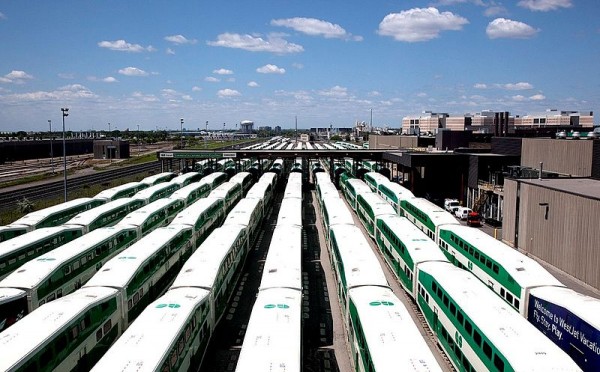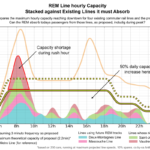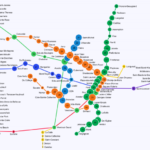Could Commuter Rail Equipment be Used for Affordable Intercity Travel?
February 25th, 2013 by ant6n
Toronto Commuter rail equipment waiting for the evening rush. source
The rail operator in France just started marketing a truly low cost high speed rail option. SNCF will soon start a new rail service under the name OuiGo (yes go! we go!), offering travel as cheap as 10 Euros for travels as far as 500 miles. This may be the cheapest HSR tickets anywhere in the world, and offer quite the competition to low cost air carriers or driving. Just like with the cheap airlines, users may have to deal with some inconveniences: passengers have to pay to bring more bags and to use electrical outlets, there are no cafe cars. And the travel doesn’t start in central Paris, but rather 20km east in Marne La Vallée, to avoid the higher track fees of downtown Paris. That’s similar to how low-cost air carriers offer travel from cheaper outlying airports. Unlike those airlines, though, SNCF is still offering uncompressed seating. 1,268 passengers can fit into the duplex-TGVs by ditching the cafe car and using an all economy layout.
This service got me thinking whether in North America we could have at least cheap medium speed rail options. Both VIA in the Quebec-Windsor corridor and Amtrak in the North-East Corridor offer reasonably fast service, but at prices and with service that appears to attempt competing with air travel. Both Amtrak and VIA neither have the capacity, nor speed to compete with low cost airlines. But they may be able to compete with cars and affordable bus travel offered by Chinatown buses or Megabus.
VIA and Amtrak may not have the equipment to offer afforable high-capacity service. But there’s plenty of rail equipment laying around most of the day that could be used for exactly that — commuter trains. The standard North American commmuter rail paradigm offers service mostly (if not only) during peak hours, dumping large numbers of trains in downtown yards, waiting to rush back to the ‘burbs during the late afternoon. I would prefer they would be used for all day frequent service, but there will always be unused trains during the off-peak. Could they be used to offer affordable intercity service instead of clogging up space downtown?
Let’s check the schedules of two commuter rail lines in Montreal to see when all the trains are really needed. The services use fewer trains than departures, because the earlier trains return back to the origin and do another run. For the Mont St Hilare line, the train arriving at 7:50 in downtown can’t make it back to the end of the line soon enough to be part of the morning rush – it becomes dead weight downtown. Only one train is needed for the midday service. For the evening rush, all trains are used starting with the 16:50 departure. For the Candiac line, there’s one train unused between 8:40 and 16:15. Overall, there are time slots of 7-8 hours during mid-day, and up to 6 hours after 6-7pm, when trains could be used for other duties.
Mont St Hilaire line (55 minutes per run): arrive downtown: 06:30, 07:25, 07:50, 08:20, 08:50, 14:30, 19:25 depart downtown: 12:30, 15:50, 16:30, 16:50, 17:20, 18:00, 19:45
Candiac Line (40minutes per run):
arrive downtown: 06:40, 07:15, 07:40, 08:17, 08:40, 09:05, 09:30, 11:10, 14:00
depart downtown: 09:35, 12:20, 15:40, 15:55, 16:15, 16:45, 17:15, 17:55, 18:20
Commuter rolling stock may be a good match for high affordable high capacity intercity rail that doesn’t threaten the existing ‘premium’ rail market. It offers less space per passenger, but still much more than cars, buses or aircrafts. There’s also less space for baggage, meaning that it may have to be restricted in some way, just as for the OuiGo service in France. Commuter rail rolling stock offers a large amount of capacity, so even with cheap tickets the service may still be economically feasible. There are few amenities: no cafe cars (although one could install snack vending machines), no outlets (that’s a bummer for laptop carrying students), no wifi.
The cars tend to have lower maximum speed (100mph vs 125mph, or 80mph vs 100mph), so travel times may be slightly longer. This could be offset by having fewer stops, only at larger stations. Not stopping at small towns also matches trying to tap into large travel markets, and not competing too much with existing rail options for smaller markets. With fewer stops, fewer conductors are feasible because there is more time to check tickets between stops.
Travel between 9am and 5pm cut into regular work hours and is thus inconvenient for work-related travel. Travel after 6-7pm, i.e. twoards the end of the evening rush, with arrivals around midnight, may again be somewhat inconvenient for business traveless who may prefer taking intercity trains towards the beginning of the evening rush, in order to arrive during more reasonable times.
Schedule possibilities
A 7-8hour mid-day time slot allows for travel back and forth in the 2.5 to 3.5 hour range. Along the Quebec Windsor Corridor, this could match city paris like Montreal-Quebec, Montreal-Ottawa, Montreal-Kingston, Toronto-Kingston, Toronto-London. In the US, Philadelphia-New York, Philadelphia-DC and New York-Albany are easily doable, other city pairs will take longer than 4 hours.
In order to connect better city pairs that are more than 4 hours apart like New York-Dc, Montreal-Toronto, and Boston-New York, all of which have compatible commuter rail operations, one could send a train from each city to the other during the mid-day. The two trains could be used in the evening rush service at the destination city, for a sort of away game. The trains could then return either after the rush hour for a late night return, or during the next day. Equipment should be available during the whole weekend, allowing even more departures.
A note about non-main station departures: Gare Centrale in Montreal uses high-level platforms, which Toronto’s bilevel commuter cars can’t access. But the existing commuter rail stations of Vendome and Lucien L’Allier in Montreal are low platform, not far from downtown, and connected via the metro. In New York, there may be capacity issues going through the Hudson tunnels that connect Manhattan and New Jersey. If it’s impossible to add train departures even during mid-day, it may still be possible to have the trains depart from a New Jersey location that is accessible by rapid transit (i.e. Hoboken or Newark).



February 26th, 2013 at 06:47
Infrastructure and monitoring of the infrastructure. In France, everything is already in place. In Canada, it is a bit cave age for the infrastructure : not enough tracks, platforms, no systems for monitoring the trains with high traffic, etc. etc. etc. It is sad that so few development is made into the rails system.
February 27th, 2013 at 18:10
What would happen to the evening commuters if their trip relied on a trainset that was expected to arrive with turnaround time to spare from Toronto, but got delayed due to weather?
In southern Ontario, there is no jurisdictional obstruction. I don’t think there is anything preventing GO Transit from expanding their train offerings during the day, and running trains between Toronto, London and Windsor if they wanted to. They already run weekend trains all the way to Niagara Falls.
February 27th, 2013 at 20:18
@Stewart
The same thing that would happen any time a train is delayed, and the equipment needed for the next one – more delays.
One way to deal with that is have lots of padding in the schedules – and the numbers that I used have a fair amount of padding in them (1-3 hours). The padding before the commuter runs can be made larger than before the intercity runs – this will result in the intercity runs to be more likely to be late, but the commuter runs to be more likely to be on time, if there are delays. But a 30 minute delay for a cost-conscious city-traveller is more excusable than a 30 minute delay for a commuter.
March 4th, 2013 at 01:23
MBTA equipment cannot go into New York. First of all, it’s diesel, which isn’t allowed in the tunnels. Second, the bilevel cars are too big for NYP. Suppose you only ran them as far as a destination in Connecticut? Well, there’s a limit on the number of trains per day over the Shore Line Road because of the need for moveable bridges to be open for maritime traffic, and Amtrak’s already pushing it. If there were more slots, then Amtrak would probably want them for its normal service.
That’s on top of the other issues, such as staffing.
March 4th, 2013 at 02:15
@Matthew
Firstly, the Providence line is electrified, and all stations are high platform, so MBTA and NYP are compatible. MBTA does appear to have single level coaches, even though they don’t have electric locomotives. But those can be bought, or leased, or whatever creative thing one can come up with. Secondly, not going into NYP doesn’t imply one has to stop in Connecticut. There are other stations (and not stopping downtown was part of the plan), in Long Island, north of Manhatten. Even Grand Central could work, with the rolling stock going back and forth between MBTA and metro north — It would only need one extra Diesel Locomotive with third rail shoes.
March 10th, 2013 at 18:47
I chose Connecticut because of Stamford: it has good connecting service, yards, and platform space. It already turns CDOT diesels. But all of this is moot. The Shore Line Road can only accommodate a certain number of trains per day and it’s already at that limit. Any increase in that limit will be allocated to Amtrak or CDOT for its own Shore Line service.
April 26th, 2013 at 16:32
Another factor would be washroom facilities. Commuter trains usually have limited facilities (if any at all).
April 26th, 2013 at 16:51
Actually most modern commuter trains include washroom facilities. If commuter cars were diverted for temporary intercity service, it should be ensured that only ones with toilets aboard are picked. That said, the ratio of passengers to toilets would be lower, but that probably fits the idea of having a more affordable, lower quality service.
March 27th, 2014 at 21:25
It’s a good idea, although you should emphasis the bargain fares you are intending. I could see having train sets waiting for 9 am departures from Toronto and Montreal on a no reservations, $50 fare. As you say, let them run the pm rush as visitors, and then return home on an evening schedule.
May 6th, 2019 at 22:58
This is a brilliant idea… so imagine that the Commuter train arriving in Downtown Montreal at 0850 (originating in Mt. St. Hillaire) left montreal on a Kingston bound journey at 0900… making stops in Cornwall, Brockville and terminating at Kingston station at 11:30, then turning back at noon, arriving in Montreal for 1430…
Now imagine that a GOTransit train left Toronto Union Station at 0830, making stops in Coburg and Belleville and terminating at Kingston station at 11:30, and turning back at noon, arriving at Union for 3pm…
This scheduling would ensure no modifications are needed on platforms at Toronto Union or Montreal Gare Central, and no exchanges of equipment either…
Kingston is a fast growing city, and there are plans to replace the existing 1974 station… a rail service like this could be part of the design process for Kingston’s new station… Imagine a platform where at one side, a bi-level GOTrain would arrive, and directly across a spacious, enclosed island platform, an AMT train would arrive, and passangers could easily transfer from train to train… the 30 minute layover in Kingston would give the required wiggle room to ensure passagers made their connections in the event of a delayed train…
A passager could board a bilevel GO train at Union Station in Toronto at 0830, arriving in Kingston at 1130… fetching a cup of coffee at the new Kingston station, and boarding the 1200 AMT train, arriving at Gare Centrale at 1430…
You could forseeably run a rail service with the following schedule:
AMT – Midday “Stlawrence Connector”
Montreal (Depart) 0900
Kingston (Arrive) 1130
Kingston (Depart) 1200
Montreal (Arrive) 1430
GOTRANSIT – Midday “Lakeshore Connector”
Toronto (Depart) 0830
Kingston (Arrive) 1130
Kingston (Depart) 1200
Toronto (Arrive) 1500
AMT – Evening ” St. Lawrence Connector”
Montreal (Depart) 1900
Kingston (Arrive) 2130
Kingston (Depart) 2200
Montreal (Arrive) 0030
GOTRANSIT – Evening “Lakeshore Connector”
Toronto (Depart) 1830
Kingston (arrive) 2130
Kingston (Depart) 2200
Toronto (arrive) 0100
GOTRANSIT – Midday “Thames Connector”
Toronto (Depart) 1000
London (Arrive & Depart) 1200
Toronto (Arrive) 1400
GOTRANSIT – Evening “Thames Connector”
Toronto (Depart) 1930
London (Arrive & Depart) 2130
Toronto (Arrive) 2330
AMT – Midday “Ottawa-Outauais Connecter”
Montreal (Depart) 1000
Ottawa (Arrive & Depart) 1200
Montreal (Arrive) 1400